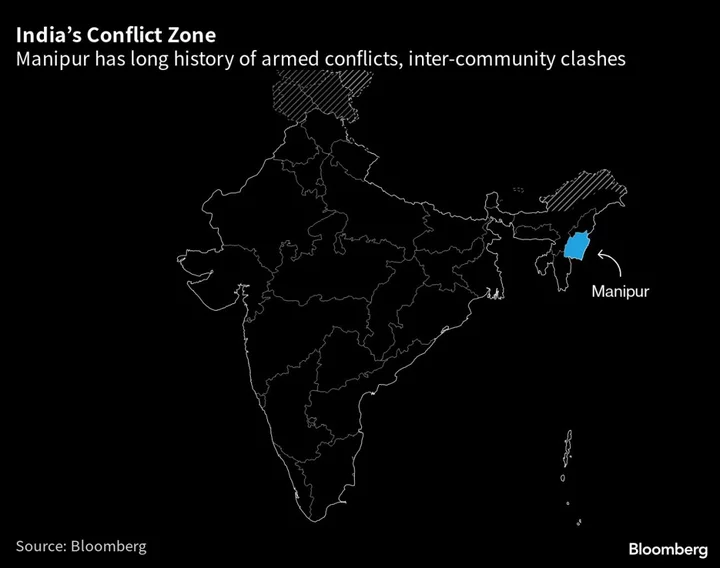Prime Minister Narendra Modi weighed in on the ongoing violence in India’s most remote state of Manipur, breaking months of silence after a video surfaced on social media showing two women getting sexually assaulted.
“What happened with the daughters of Manipur can never be forgiven,” he told reporters this week.
The clip, which has been taken down, triggered national outrage over sexual crimes that are often seen as a taboo in the world’s largest democracy where women and girls fear retribution if they report attacks. It also brings into focus the ethnic conflict in a state ruled by Modi’s Hindu nationalist Bharatiya Janata Party that stemmed from a dispute involving access to affirmative action benefits.
While security forces have put down much of the violence that began in early May and left more than 150 people dead and 50,000 displaced, there’s simmering unrest.
The conflict in the state that borders Myanmar is the worst in recent decades and is reminiscent of the 1990s when the area was in the grips of brutal insurgencies and ethnic conflicts. Some had their roots in the former princely state’s merger with India in 1949 – two years after the South Asian nation gained independence from the British.
Here’s what we know about Manipur’s deadly clashes and the alleged sexual assault case:
What spurred the violence?
Tensions first erupted between some of the area’s largely-Christian tribal groups and the majority Meitei Hindu residents in early May over a demand that Meiteis also be granted access to forest lands, jobs and seats in educational institutions set aside for tribespeople under India’s affirmative action guarantees.
India’s northeastern states lag behind most of the country in terms of development and government jobs are the main source of employment.
Meiteis account for over 50% of the state’s population and live mainly in the Imphal valley. The Scheduled Tribe status under India’s constitution would expand their access to the benefits that are available to the tribes in the surrounding hills.
The main tribal groups, the Kukis and Nagas, make up 40% of Manipur’s population and live mainly in the hills. Tribal groups fear that giving special tribal status to Meiteis would lead to their gradual removal from hill areas and leave them vulnerable to exploitation.
The current violence is largely between the Kukis and Meiteis.
What is at the heart of the conflict?
The Meiteis, Kukis and Nagas have diverse cultures and traditions and compete for the same land, natural resources and political power.
At the heart of the conflict between them is the long-standing hills versus valley identity divide and the disparities in development between the two. Meiteis are the politically dominant community, and what little infrastructure development the state has seen is largely limited to the valley. It’s also where the better government jobs are based. The group is restricted by law from purchasing land in the hill areas.
The tribal groups can buy and own land anywhere in the state, leading to a perception among a section of the Meiteis that these ethnic communities get benefits disproportionate to their population.
A rush of refugees from Myanmar following the 2021 military coup has added another layer of complexity to the ethnic divide. The refugees share ethnic ties with the Kukis of Manipur, leading to fears among the Nagas and the Meiteis that the influx will boost the population of the Kukis.
Manipur shares a 350-kilometer (217.48 miles), largely unfenced border with Myanmar.
What’s happened with the sexual assault case?
The video clips appeared on social media this week showing two women paraded naked by a group of men in Manipur in early May, around the same time violence first broke out in Manipur. It took two months to surface as the government blocked internet access to stem protests and maintain law and order, a common tactic used in troubled regions.
Local police have filed a case against the perpetrators in the video for abduction, gang rape and murder. Four people have been arrested so far.
India’s top court has described the video as “deeply disturbing.” The judges asked the federal and state governments to report steps taken against the perpetrators at a hearing scheduled for July 28.
What role does politics play?
The state’s 60-member legislature gives Meiteis an edge because 40 lawmakers are from the Imphal valley. In 2017, the BJP and its allies formed a government in the state for the first time. It returned to power in 2022.
Proceedings in both houses of federal parliament were stalled on Thursday after opposition lawmakers shouted slogans demanding a debate on the situation in Manipur. The impact of the violence on national politics is limited. The tiny state sends only two lawmakers to the 543-member lower house of federal parliament.

